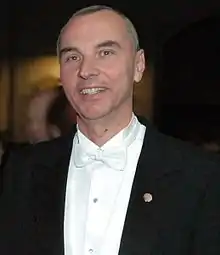Peter Stoica
Peter (Petre) Stoica[1] (born 1949) is a researcher and educator in the field of signal processing and its applications to radar/sonar, communications and bio-medicine.[2][3][4] He is a professor of Signals and Systems Modeling at Uppsala University in Sweden, and a Member of the Royal Swedish Academy of Engineering Sciences, the United States National Academy of Engineering (Foreign Member), the Romanian Academy (foreign honorary, since 1991),[5] the European Academy of Sciences,[6] and the Royal Society of Sciences. He is also a Fellow of IEEE,[7] EURASIP,[8] IETI, [9]and the Royal Statistical Society.

He is known for his theoretical contributions to system identification and modeling, spectral analysis, array signal processing, space-time coding, and waveform design for active sensing. His practical contributions include the areas of wireless communications, microwave imaging for breast cancer detection, radar/sonar systems, acoustic source mapping, landmine and explosive detection, and magnetic resonance spectroscopy and imaging. His books on System Identification, Spectral Analysis, and Space-Time Coding for Wireless Communications have been used in both undergraduate and graduate courses and are highly cited (his works rank in the top 1% by citations for the field of engineering).[10] He has been included on the ISI list of the 250 most highly cited researchers in engineering in the world.[11][12]
Selected awards
- The IEEE ASSP Senior Award, 1989[13][14]
- Honorary doctorate from the Faculty of Science and Mathematics at Uppsala University, Sweden 1993[15]
- The Shannon-Nyquist Technical Achievement Award of the IEEE Signal Processing Society, 1996[16][17]
- The IEEE W.R.G. Baker Award, 2000[18]
- The IEEE Third Millennium Medal, 2000
- The EURASIP Individual Technical Achievement Award, 2002[19]
- The Bjorkenska Prize, 2004[20]
- The IEE Achievement Medal, 2005[21]
- The Wiener Society Award of the IEEE Signal Processing Society, 2006[22]
- The Barry Carlton Award of the IEEE Aerospace and Electronic Systems Society, 2008[23]
- The IEEE Signal Processing Society Best Paper Award, 2013
- The EURASIP Athanasios Papoulis Award, 2016[24]
- Rudbeck Gold Medal, 2016[25]
- The IEEE Fourier Award for Signal Processing, 2018[26]
- The C.F. Gauss Education Award of the IEEE Signal Processing Society, 2019[27]
Selected publications
(out of 800 scientific papers and 30 books and book chapters[28])
- T. Söderström and P. Stoica, System Identification. Prentice-Hall, London, United Kingdom, 1989 (Paperback Edition 1994, Polish Edition 1997, Chinese Edition 2017).
- P. Stoica and R. Moses, Introduction to Spectral Analysis. Prentice-Hall, Englewood Cliffs, USA, 1997. available for download.
- P. Stoica and A. Nehorai, Music, Maximum likelihood and the Cramér-Rao bound. IEEE Trans. Acoustics, Speech, Signal Processing, vol. ASSP-37, 720–741, 1989.[29]
- E Larsson and P Stoica,Space-Time Block Coding For Wireless Communications. Cambridge University Press, UK, 2003 (Chinese Edition, 2006).[30]
- P Stoica and R Moses, Spectral Analysis of Signals. Prentice Hall, NJ, 2005 (Chinese Edition, 2007). available for download.
- H Sampath, P Stoica and A Paulraj, Generalized linear precoder and decoder design for MIMO channels using the weighted MMSE criterion. IEEE Trans Comm, vol 49, 2198–2206, 2001.[31]
- A Scaglione, P Stoica, S Barbarossa, G Giannakis and H Sampath. Optimal designs for space-time linear precoders and decoders. IEEE Trans Signal Processing, vol 50, 1051–1064, 2002.[32]
- J Li, P Stoica and Z Wang, On robust Capon beamforming and diagonal loading. IEEE Trans Signal Process, vol 51, 1702–1715, 2003.[33]
- J Li and P Stoica, MIMO radar with colocated antennas: review of some recent work. IEEE Signal Processing Mag., 106–114, September, 2007.[34]
- P. Stoica and A. Nehorai, Performance study of conditional and unconditional direction of arrival estimation. IEEE Trans. Acoust., Speech, Signal Process., vol. ASSP-38, 1783–1795, Oct. 1990.[35]
Citation counts for the above publications can be found at: Google Scholar page.
References
- "Web Page".
- "EURASC Recent Elected Members". Archived from the original on 2012-04-05. Retrieved 2013-05-13.
- "12 top researchers in Sweden receive money from ERC". Archived from the original on 2013-06-15. Retrieved 2013-05-13.
- "ERC Advanced Grant: Peter Stoica". Archived from the original on 2013-06-16. Retrieved 2013-05-13.
- (in Romanian) Membri de onoare din străinătate at the Romanian Academy site
- "Members of European Academy of Sciences".
- "IEEE Fellow members".
- "EURASIP Fellow Members".
- "IETI Fellow Members".
- "The world's most influential scientific minds" (PDF).
- ""ISI Highly Cited": a database of "highly cited researchers"". Archived from the original on 2013-05-02. Retrieved 2013-05-13.
- "Google Scholar Page".
- http://www.signalprocessingsociety.org/awards-fellows/awardspage/best-paper/
- "IEEE Signal Processing Society Best Paper Award (formerly known as the Senior Award)" (PDF).
- http://www.uu.se/en/about-uu/traditions/prizes/honorary-doctorates/
- http://www.signalprocessingsociety.org/awards-fellows/awardspage/techachv/
- "IEEE Signal Processing Society Technical Achievement Award" (PDF).
- "IEEE W. R. G. Baker Prize Paper Award Recipients".
- "Technical Achievement Award".
- sv:Björkénska priset
- "Achievement Medal Recipients" (PDF).
- "IEEE Signal Processing Society Society Award" (PDF).
- "M. Barry Carlton Award".
- "Athanasios Papoulis Award".
- "Rudbeck Medal".
- "IEEE Fourier Award".
- "IEEE Signal Processing Society Carl Friedrich Gauss Education Award" (PDF).
- "List of Publications".
- Stoica, P.; Nehorai, Arye (1989). "MUSIC, maximum likelihood, and Cramer-Rao bound". IEEE Transactions on Acoustics, Speech, and Signal Processing. 37 (5): 720–741. doi:10.1109/29.17564.
- http://www.cambridge.org/gb/knowledge/isbn/item1170663/?site_locale=en_GB
- Sampath, H.; Stoica, P.; Paulraj, A. (2001). "Generalized linear precoder and decoder design for MIMO channels using the weighted MMSE criterion". IEEE Transactions on Communications. 49 (12): 2198–2206. doi:10.1109/26.974266.
- Scaglione, A.; Stoica, P.; Barbarossa, S.; Giannakis, G.B.; Sampath, H. (2002). "Optimal designs for space-time linear precoders and decoders". IEEE Transactions on Signal Processing. 50 (5): 1051–1064. Bibcode:2002ITSP...50.1051S. doi:10.1109/78.995062.
- Jian Li; Stoica, P.; Zhisong Wang (2003). "On robust capon beamforming and diagonal loading". IEEE Transactions on Signal Processing. 51 (7): 1702–1715. Bibcode:2003ITSP...51.1702L. doi:10.1109/TSP.2003.812831.
- Li, Jian; Stoica, Petre (2007). "MIMO Radar with Colocated Antennas". IEEE Signal Processing Magazine. 24 (5): 106–114. Bibcode:2007ISPM...24..106L. doi:10.1109/MSP.2007.904812.
- Stoica, P.; Nehorai, A. (1990). "Performance study of conditional and unconditional direction-of-arrival estimation". IEEE Transactions on Acoustics, Speech, and Signal Processing. 38 (10): 1783–1795. Bibcode:1990ITASS..38.1783S. doi:10.1109/29.60109.